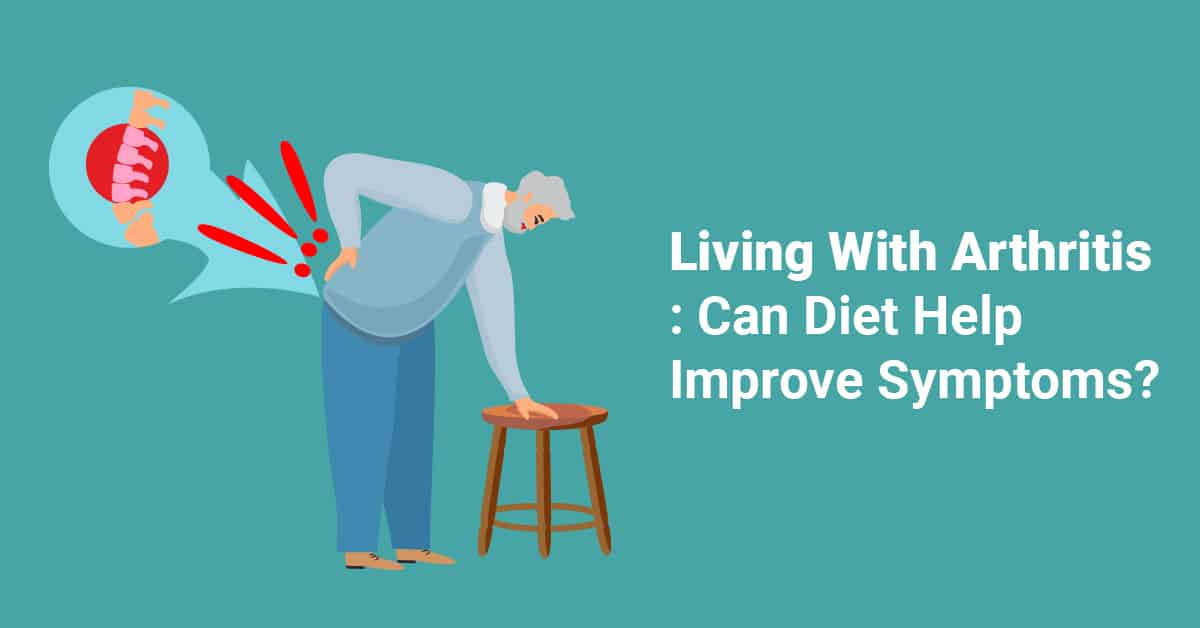
Arthritis is a common condition which affects around 15% of the UK population. This equates to around 10 million people. For some people, it comes as a part of getting older. But does this have to be the case?
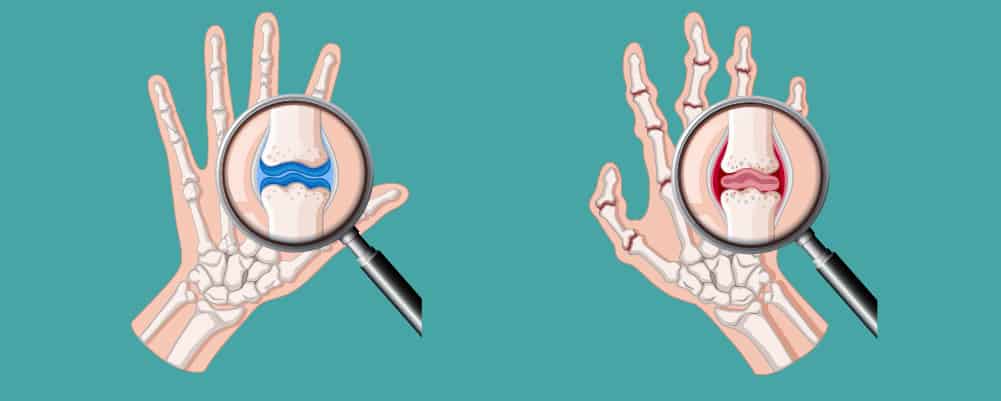
There is no cure for arthritis. So the only option is to treat the symptoms. The main symptoms include pain, tenderness, stiffness, and inflammation in the joints. Different people will experience different symptoms. And these can vary throughout life.
So, what can be done about these symptoms? There are strong arguments that eating specific foods, as well as avoiding others, can help reduce the symptoms of arthritis. Here are some of the main dietary changes that can help ease the symptoms of arthritis.
Main Topics
Living with Arthritis
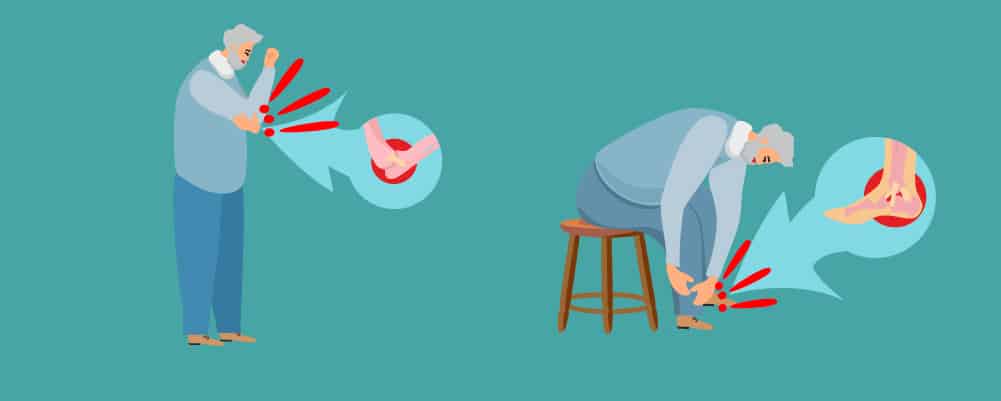
Arthritis can be a difficult condition to live with. It affects the joints and can make movement difficult. There are five main types of arthritis. These are:
Osteoarthritis
Osteoarthritis is one of the most common types of arthritis. It is primarily caused by an overuse of the joints. Which is one of the reasons why it is so common in older age. However, it can be caused by other factors, such as weight gain putting pressure and strain on your joints.
Osteoarthritis is most commonly found in the parts of your body which bear your weight. This includes the knees, spine, hips, and feet. Osteoarthritis occurs when the cartilage within the joints breaks down. It is the cartilage that absorbs shock.
This can make the joints stiff and painful. It also makes movement difficult. Joints can also become swollen and will feel warm to the touch.
Rheumatoid Arthritis
Rheumatoid arthritis is an autoimmune disease. Similarly to osteoarthritis, it is most commonly found in the joints. But it is caused by the immune system attacking the joints. Rather than excess strain or pressure.
A symptom of rheumatoid arthritis is a series of lumps on the skin. These are usually found on the joints that are affected. The cause of rheumatoid arthritis is not currently known. However, some theories suggest that the immune system becomes confused and essentially malfunctions. This can often occur after it has fought off an infection or a virus.
The main symptoms of rheumatoid arthritis are similar to other kinds of arthritis. These include stiffness, pain, and swelling in the joints. However, rheumatoid arthritis can be more severe than osteoarthritis.
Psoriatic Arthritis
Psoriatic arthritis is a combination of the skin condition psoriasis and arthritis. Psoriasis causes itchy red patches on the skin that are dry and scaly. They usually appear on the elbows, knees, scalp, and torso.
Around 10% to 30% of people with psoriasis also have arthritis. As with arthritis, there is no cure for psoriasis. It is a chronic and lifelong condition. Signs can begin to appear in childhood. But it usually starts between the ages of 30 and 50.
Unlike osteoarthritis and rheumatoid arthritis, psoriatic arthritis is more isolated. It will usually only appear in one joint. Or sometimes in the spine.
Gout
Gout is often considered a separate condition of its own. But it is in fact a type of arthritis. Gout is a chronic condition which usually occurs in flares ups or attacks. Gout is most commonly isolated to the big toe. And attacks can be identified through a sharp pain in the big toe.
Gout can be caused by the body making excess uric acid or your kidneys not being able to process the uric acid your body is producing. The symptoms of gout are similar to other kinds of arthritis. These can include stiffness, inflammation, and redness around the joints. As well as a difficulty moving.
It can be differentiated from other forms of arthritis by the sharp pain in the toe. As well as the infrequency of the attacks. These attacks can last from anywhere between 3 and 10 days. The pain can also spread upward through the body.
Lupus
Lupus is also an autoimmune disease. Similarly to other types of arthritis, lupus affects the joints. But it can also affect internal organs. Similarly to rheumatoid arthritis, the cause of lupus is unknown. But it is thought that your immune system becomes confused and weakened. The immune system causes pain and inflammation in joints but also internal organs and sometimes the brain.
The symptoms of lupus are more wide-ranging than other types of arthritis. These are:
- Blood disorders (such as anaemia)
- Chest pain (caused by inflammation in the lining of the lungs and/or heart)
- Fatigue
- Fingers and toes turning blue or white when cold (this is called Raynaud’s phenomenon
- Hair loss
- Headaches
- Mouth sores
- Painful and swollen joints
- Rashes
- Sun sensitivity
- Swelling in the joints, feet, legs, hands, and/or around the eyes
Does Weight Affect Arthritis?
As mentioned above, carrying extra weight can cause arthritis to develop. This is because the joints are taking extra strain and pressure. Essentially, the body is carrying more weight than the frame can support.
Losing weight can help reduce the symptoms of arthritis. This is because it will reduce the strain on the joints. However, there is no cure for arthritis. And it cannot be reversed. Once the damage has been done to the cartilage, it cannot be restored.
This doesn’t mean that losing weight won’t have an impact. So it is worth considering if your weight is a factor in your arthritis. And changing your diet can have an impact on the symptoms. However, changing your diet will not reverse the arthritis.
Do Certain Foods Cause Arthritis?
So, if certain foods can help reduce the symptoms of arthritis, does this mean that other foods can cause it? Not really. In a roundabout way, it could be argued that food can be the cause of arthritis if the arthritis is caused by excess weight. However, this is reductive. And it is unhelpful to tell someone with arthritis to simply eat less.
Instead, the best option is to avoid foods which cause inflammation. Certain foods can increase inflammation in the body. Which, as inflammation is a symptom of arthritis, can make the condition worse and more painful.
Here are some foods and drinks that people with arthritis should avoid:
- Alcohol
- Aspartame
- Gluten and Casein
- MSG
- Refined Carbohydrates
- Omega 6 Fatty Acids
- Trans Fats
- Saturated Fats
- Sugar
If you’re looking at the above list and thinking “but those are my favourite things”, you aren’t alone. A lot of the foods which cause inflammation are those which generally aren’t very good for you. So, the best thing to do is to change your diet to an overall healthier one. You don’t have to cut these foods out entirely. But you can save them for treats and special occasions.
Why Choose a Mediterranean Diet for Arthritis

So, now you know which foods to avoid, let’s move on to the foods you should be adding to your diet. You will have very likely heard of what is called the “Mediterranean diet”. It is regularly touted as one of the healthiest diets. And by “diet”, we don’t mean a fad diet such as smoothie cleanses and going carb-free.
The food we eat has a much greater impact on our bodies than we generally think. Most of us can draw a direct line between eating too much or eating foods with high sugar and saturated fat contents with gaining weight. (However, weight gain is often much more complex than that.) But seeing the connection between food and inflammation, heart disease, and fatigue isn’t quite so simple.
If you do not feel that you could switch to a Mediterranean diet entirely, it’s a good idea to simply swap out some elements. For example, cooking your food in extra virgin olive oil instead of butter. Or filling out your dishes with more vegetables.
What is a Mediterranean Diet?

The Mediterranean diet is a way of eating that includes a lot of healthy fats, complex carbs, and fresh fruits and vegetables. Its name is derived from the fact that this style of eating is common in countries along the Mediterranean. Here are the main foods which are staples of the Mediterranean diet.
Fish
Fish is considered one of the healthiest meats. It is an excellent source of Omega 3 fatty acids. Humans cannot produce Omega 3 fatty acids themselves. So they should make up a good proportion of your diet.
Omega 3 fatty acids have been shown to reduce inflammation. Good sources of Omega 3 fatty acids are salmon, tuna, sardines, herring, anchovies, and scallops.
If you don’t like fish or are vegetarian or vegan, then you can easily find supplements for Omega 3 fatty acids that do not contain any fish.
Nuts and Seeds
Nuts and seeds are another great source of Omega 3 fatty acids. Especially if you can’t or don’t want to incorporate fish into your diet. Nuts are also “heart healthy”. So they are especially good for people with rheumatoid arthritis.
Some people avoid nuts due to their high fat and calorie content. But this is due to a warped perception of what is considered “healthy”. Compared to, for example, kale, you wouldn’t eat the same amount of nuts and seeds as you would this leafy green. So the calorie content will balance out. Plus, calories aren’t a “bad” thing. They also contain healthy fats that are essential for your diet.
Nuts and seeds are nutrient dense and excellent for your overall health. Here are the best nuts to add to your diet to reduce inflammation:
- Walnuts
- Pine Nuts
- Pistachios
- Almonds
Due to their density, it’s best to keep portions to a handful or so a day. A study has shown that people who ate a handful of nuts five times a week had 20% lower levels of C-reactive protein (CRP) and 16% lower levels of interleukin-6 (IL-6) which are both markers of inflammation.
Fruits and Vegetables
Despite what the food pyramid tells you, fruits and vegetables should be your main sources of food. This is especially true of vegetables, including leafy greens and vegetables made up of complex carbohydrates.
The best fruits and vegetables which are especially good for reducing inflammation are:
- Blueberries
- Cherries
- Spinach
- Kale
- Broccoli
But, you should not limit your diet to just these fruits and vegetables. You should pack your meals with vegetables. And then have fruit as snacks or as breakfast. This will help with providing fibre in your diet. Fibre is important for reducing inflammation.
Olive Oil
Olive oil, especially extra virgin olive oil, is one of the main staples of the Mediterranean diet. It is a healthy fat and can help reduce inflammation. It is also a great alternative to other, less healthy fats which can increase inflammation. And an increase in inflammation means an increase in joint pain.
Switching out other fats, such as butter or margarine, are also good for reducing cholesterol. This will in turn make you less prone to heart disease. People with arthritis, especially osteoarthritis, have a 24% higher risk of developing heart disease. So switching to olive oil has multiple health benefits.
That said, as with all foods no matter their nutrient content, don’t go overboard. Only two to three tablespoons a day is necessary. This can be used to cook oil, season food, or used as a dressing on a salad.
Beans
Due to their high fibre content, beans are excellent for reducing inflammation. As mentioned above, fibre is an important part of any diet. But especially for those looking to reduce inflammation. This is also partly due to the part fibre plays in weight management.
Whole Grains
Whole grains are another excellent source of fibre. This is because whole grains are complex carbohydrates. Whole grain foods, such as brown bread, wholewheat pasta, brown rice, and whole grain couscous, are all higher in fibre than their simple carbohydrate counterparts.
Simple carbohydrates are essentially the “white” versions of the foods listed above. They aren’t necessarily bad for you. And they will have similar calorie contents to their whole grain counterparts. However, for your everyday meals, whole grain alternatives are a much better option.
The increased fibre in these foods can reduce bloating, improve digestion, and, of course, reduce inflammation. They can also be part of a diet aimed at losing weight. Which would help to reduce the pressure on arthritic joints. But, as mentioned above, weight loss is not the cure-all that many people believe it to be.
Nightshade Vegetables
Nightshade vegetables isn’t a term heard very often. But it refers to vegetables that are all part of the nightshade family. (Yes, deadly nightshade is part of this family. But don’t worry, we’re not suggesting that.)
Vegetables in the nightshade family include aubergines, tomatoes, and bell peppers. Which can all be seasoned with other members of the nightshade family, such as cayenne pepper and paprika. So, despite the list at the beginning which seemed to ban all the best foods, you can see that there are plenty of delicious dishes you can make with healthy anti-inflammatory foods.
Mediterranean Diet Benefits

We have already mentioned some of the main benefits of the primary foods which make up the Mediterranean diet. These predominantly relate to decreasing inflammation. So it is especially useful for one of the main symptoms of arthritis. As inflammation is a common side effect. And puts further pressure and strain on the damaged joints.
But a Mediterranean diet has many other benefits. Some of these can help with symptoms of arthritis. As well as many other health problems. The Mediterranean diet is also recommended as an everyday diet for all people. As it is one of the healthiest and most well-balanced diets. Here are some of the main benefits of the Mediterranean diet.
Lower Blood Pressure
The Mediterranean diet includes a lot of fat. Mostly found in fish and oil. However, these are very healthy fats. For a long time, many fad diets have instructed people to avoid any kind of fat. Mistakenly assuming it will cause people to gain weight and store extra fat.
But there are healthy and less healthy fats. The fats found in the Mediterranean diet are “heart-healthy” fats. These can help reduce the risk of heart disease, lower cholesterol, and lower blood pressure.
Incorporating healthy fats into your diet is good for a range of reasons. But it can be especially helpful for people with arthritis. This is because arthritis, especially rheumatoid arthritis, gout, lupus, and psoriatic arthritis, can make those with the condition more susceptible to heart disease. So, lowering your blood pressure, especially if you have gout, is a good idea.
Protect Against Chronic Conditions
As well as protecting against symptoms of arthritis, a Mediterranean diet can also help reduce the symptoms of other chronic conditions. Especially through the way it reduces inflammation.
Studies have also shown that a Mediterranean diet can even help to prevent the development of chronic conditions. As well as other serious illnesses. This includes strokes, breast cancer, dementia, IBS, and colorectal cancer.
While, of course, a Mediterranean diet cannot cure these illnesses. And they do they provide a 100% surety against someone developing them. However, having a healthy and well-balanced diet, such as the Mediterranean diet, appears to significantly improve your health, wellbeing, and longevity.
Help Arthritis by Curbing Inflammation
As mentioned above, one of the best results of the Mediterranean diet is its ability to reduce inflammation. Some foods and beverages, such as processed sugar and alcohol, can cause a reaction in your body which results in inflammation.
Research shows that some foods can affect the levels of the C-reactive protein which is present in the blood. This is a marker of inflammation. The exact causes of this are not yet fully understood. However, research has shown that certain foods, such as those in the Mediterranean diet, can help to reduce inflammation.
This is useful for all types of arthritis. As inflammation is a common symptom. But it is also useful for other chronic conditions. And for overall general health.
Lead to Weight Loss
Carrying extra weight can put a strain on the joints. This is especially difficult for those with arthritis. While weight loss can be difficult for some people. And there are a range of ways to lose weight. Keeping to a healthy Mediterranean diet can help with this.
This is especially true for people who currently have a diet high in processed sugar and saturated fat. Swapping out some foods for those on a Mediterranean diet. Or switching to it entirely, can help people who are looking to lose weight.
Mediterranean Diet Recipes
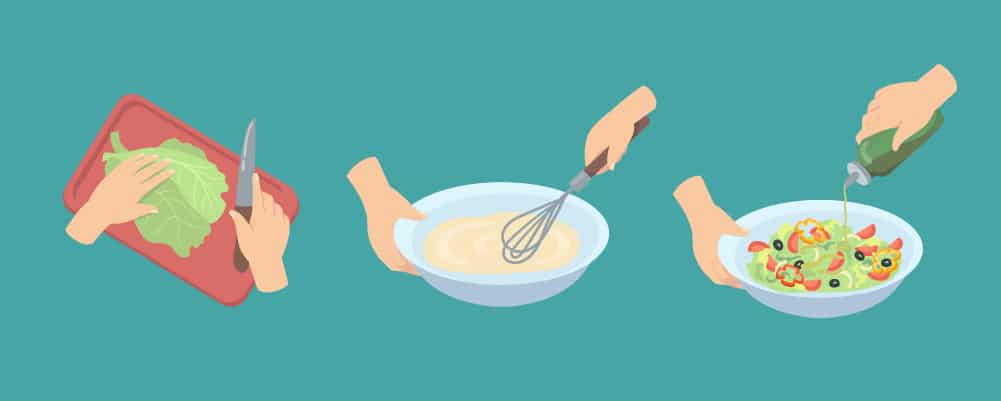
If you’re looking at the foods in a Mediterranean diet and aren’t quite sure where to start, here are some delicious and easy recipes to try.
Briam
Briam is a traditional Greek dish which uses a range of Mediterranean vegetables. This includes aubergine, courgette, and tomatoes. It also includes potatoes and red onion.
Simply slice up the aubergine, courgette, potatoes, and onion and season them with herbs, salt, and garlic. Next, take a large oven dish. Circular is most traditional.
Pour in a can of chopped tomatoes. (Or make them yourself.) If you have time, you can arrange the vegetables in an alternating pattern. However, if you don’t, then simply place them in the dish, ensuring they are well spread out.
Cover the dish with foil and place in the oven at 400F. After around 45 minutes, remove the foil. Then return to the oven for another 30 to 40 minutes. Or until the vegetables are tender.
Greek Salad
Greek salad is an excellent and easy dish. The ingredients can vary, but generally include tomatoes, olives, feta cheese (or a vegan alternative), sliced red onion, tomatoes, cucumber, and oregano. Simply mix these ingredients together. And add a tablespoon or so of olive oil.
Baked Stuffed Aubergines
This is a delicious Italian dish. Take one large aubergine and slice it in half lengthwise. Leaving the stem intact. Next, around ½ inch from the edge, cut a border in the flesh. Then scoop out the flesh inside the border and chop it into smaller pieces.
Place the shells of the aubergine drizzle with olive oil, cover with foil, and bake in the oven for around 20 minutes.
Next, fry an onion in a little olive oil until it is soft. Then add in the chopped aubergine, around 12 cherry tomatoes, and season with garlic, herbs, and a little salt. Once combined and softened, add in some olives and mozzarella or a vegan cheese alternative.
Spoon the mixture into the aubergine shells. An optional topping is breadcrumbs and more cheese. Drizzle with a little more oil and place in the oven for around 15 to 20 minutes. Or until the cheese is gooey and the breadcrumbs are golden. For a double Mediterranean meal, serve with a Greek salad.
Grilled Fish
Fish is one of the main components of a Mediterranean diet. Grilling fish is one of the healthiest ways to cook it. Simply take a fish with a healthy level of fat, such as salmon, and season it. Then, simply grill it on both sides for around 2 to 4 minutes.
Serve with whole grain couscous, a Greek salad, or another healthy side. Salmon is often included in many diets. This is due to its wide-ranging health benefits. It is also a delicious piece of meat.
Salmon can be incorporated into other dishes. This includes pasta dishes (wholewheat pasta is a high fibre alternative). Or other salads. It can also be served as the main component of a dish with sides of broccoli, asparagus, kale, and potatoes.
Mediterranean Stuffed Chicken Breast
Chicken breast is another piece of meat that is often suggested for a healthy diet. However, many people often serve it plain. Even without any seasoning. But, this is completely unnecessary. A plain chicken breast is not especially enjoyable. And adding a little seasoning or stuffing it isn’t going to have a huge impact on your health.
Mediterranean stuffed chicken breast looks impressive, but is very simple. The trickiest part is cutting open and stuffing the chicken breast. When the chicken breast is raw, take a knife and cut straight along the thickest part of the breast. Alternatively, cut the inside of the chicken breast in a butterfly style.
Next, chop up some bell peppers, red onion, fresh spinach, olives, garlic, and other seasoning. Mix them together and stuff inside the chicken breast. Place on a baking tray and brush with seasoned olive oil. Heat in a pan for two minutes on either side. Then place in the oven at around 125F for around 20 to 25 minutes. Or until the chicken is completely cooked.
Diet and Exercise = The Ultimate Pair?

Generally, a well-balanced diet and regular exercise are all you need to lead a healthy life. There are a huge number of fad diets and excessive exercise regimes that claim to fix everything from weight gain to cancer.
But incorporating regular exercise can help to reduce the stiffness associated with arthritis. Exercise can help to bring more flexibility and ease of movement. It can also help to strengthen the muscles around your joints. This can help to provide more support to the joints affected by arthritis.
Here are some exercises that can be helpful for reducing symptoms of arthritis. However, make sure to check with your doctor before beginning these. As there are different types of arthritis, within which there is more variation, some exercises might not be suitable for everyone.
Aerobic Exercises
Aerobic exercises such as walking, cycling, and swimming are great ways of exercising, without putting too much strain on the joints. Swimming is often touted as a great way to help reduce pain. Swimming helps increase circulation. It can also help increase movement and help reduce stiffness. Which is one of the main symptoms of arthritis.
Range-of-Motion Exercises
Range-of-motion exercises can help reduce stiffness and improve movement. These are simple exercises that are specifically intended to help improve the symptoms of arthritis. These are slow, regular movements. So won’t put any strain on the joints.
These exercises are similar to stretches. They are isolated on the joints and help to loosen the affected areas. This can help to reduce stiffness and pain.
Strengthening Exercises
Weight training can seem intimidating. But you don’t have to start deadlifting and bodybuilding. Simply working out with dumbbells or using the weight machines at the gym can help. Start with small weights and work your way up.
During these workouts it’s important to ensure that your joints are fully supported and protected. Especially as excessive strain on the joints can cause arthritis. It is also important to listen to your body and stop to rest whenever you feel the need to.
For weight training, it is even more important to double-check with your doctor. Weight training can be especially strenuous. So extra care should be taken.
These are some very common types of exercise. But, if these seem like too much movement for your body, there are other activities that can help. Moving your body is always important. So even activities such as mowing the lawn, cleaning the house, or walking the dog can help.
Summary
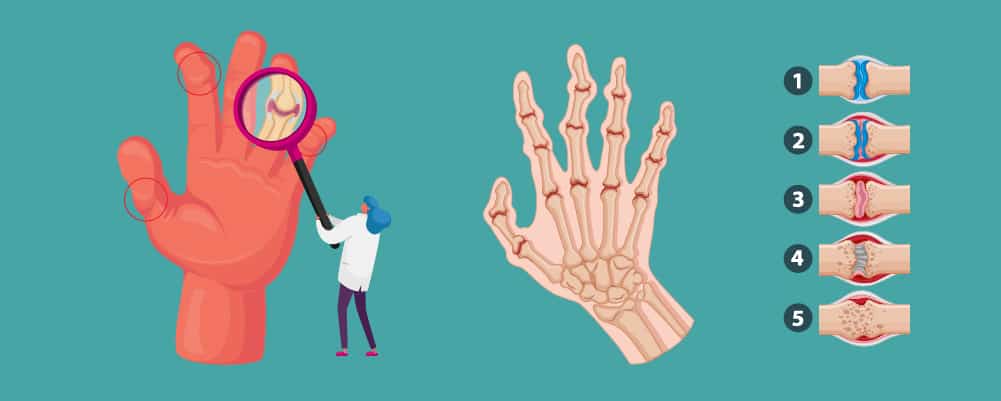
Sadly, there is no cure for arthritis. It is a chronic condition. And so can only be managed. This can be through taking arthritis and pain medication. And despite what some people might say, there are many positives to taking these medications.
However, switching up your diet, even in a small way, can have a great impact on your overall health. The main results being the reduction of inflammation. This will take much of the strain and pressure off the joints affected by arthritis. This can be especially true of rheumatoid arthritis.
You cannot cure arthritis through your diet. But you can absolutely improve the symptoms. Following a Mediterranean diet, whether you have arthritis or not, is an excellent way to improve your general health, wellbeing, and longevity.
Leave a Reply